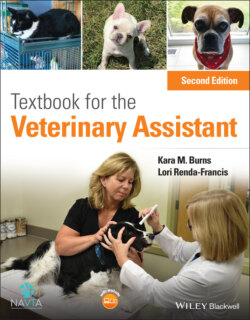Читать книгу Textbook for the Veterinary Assistant - Lori Renda-Francis - Страница 56
Lifting and positioning a dog
ОглавлениеAlways bend at the knees to pick up an animal. Do not bend over at the waist, as you put yourself at increased risk for back injury. Working with animals requires strength and proper posture. All health‐care team members must adhere to proper lifting techniques for the good of the individual, team members, and patient. After bending at the knees and keeping your back straight, you can lift a small‐breed dog by placing one hand under its mandible and your forearm under its abdomen. The dog should be carried close to your body for stability at all times. Medium‐sized dogs should be held with one arm under the neck and the other arm under the abdomen or around the dog’s hindquarters. For the safety of the pet and the safety and health and longevity of the team members, lifting large‐breed dogs requires two team members who must communicate and work together to insure safety. One person should place his or her arm around the dog’s thorax and the other arm under the dog’s neck. The other person should place one arm under or around the dog’s abdomen and the other arm around the hindquarters.
Placing a large dog on an exam table may produce anxiety for the animal, so the health‐care team should attempt to examine the dog on the floor. Alternatively, hydraulic lift tables are becoming more popular. The dog may be placed on the table at ground level and secured, with health‐care team members readily on hand. The table can then be raised to a level that allows the team to examine the dog.
Restraint while standing is necessary when the dog is undergoing a physical examination, anal sac expression, having its temperature taken rectally, or if a vaginal or rectal smear must be obtained. Restraint for these procedures involves placing one arm around the dog’s neck or muzzle and the other arm around the dog’s body. The dog must be pulled in close to the team member’s body. Large and giant‐breed dogs will require two team members to participate in the restraint. The restraint should not be a tight stranglehold on the dog but rather a tender hold with some softly spoken words. A tender hold with a well‐behaved patient was all that was needed during the physical examination in Figure 4.5. The health‐care team members must be ready at all times to tighten the grip if the patient starts to struggle or become aggressive.
Figure 4.5 Tender hold during physical examination.
Source: Courtesy of Kara M. Burns, LVT, VTS (Nutrition).
Using recumbent restraint is necessary for many procedures. Procedures such as drawing blood from a cephalic or jugular vein, administering an IV injection, oral and ophthalmic examination, and administering medications are a few of the procedures that warrant restraint in sternal recumbency. In this kind of restraint, the health‐care team member places one hand under the neck or muzzle region of the dog and the other around the hindquarters and pulls the dog in close to their body. If the dog is trying to scratch with its front paws, the team member can remove the arm from around the hindquarters and wrap it around the abdominal area with the hand coming from the underside of the dog to the front legs. The front legs should be grasped slightly above the carpal area.
Placing a dog on its side will allow for restraint in lateral recumbency. With the dog on its side, the front legs are held while the team member places one arm across its neck. The other hand is used to hold the back legs. This is a useful restraint for urinary catheterization, radiographs, suture removal, and for access to the lateral saphenous vein.
Restraint in dorsal recumbency calls for two team members. The dog is placed in lateral recumbency and is carefully rolled onto its back. The front paws are extended cranially with the back paws extended caudally. This exposes the thorax and abdomen of the dog. A V‐trough or foam wedges may be necessary to prevent the dog from rolling. This technique is often used for radiographs or cystocentesis.
